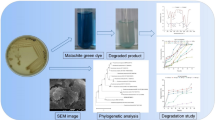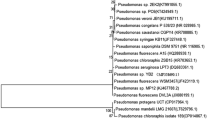Abstract
Malachite green (MG) has been focused on as a biotreatment target and its biological properties have also been an issue in food fish aquaculture. An MG-removing bacterium was isolated from aquaculture fish pond sediment samples in Thailand. The isolate, strain T-5-2, is a Gram-negative, aerobic rod-shaped bacterium, and has been identified as a member of the Pseudomonas putida group. Proton nuclear magnetic resonance spectroscopy (1H-NMR) analysis of a broth culture medium containing MG showed that the concentration of MG decreased markedly and that other molecules, including leucomalachite green (LMG), were generated. Moreover, liquid chromatography–tandem mass spectrometry (LC–MS/MS) analysis showed that the MG concentration in the broth culture medium continuously decreased. This analysis also demonstrated that the concentration of LMG initially increased and then gradually decreased. Furthermore, gas chromatography–mass spectrometry (GC–MS) analysis showed 4-(dimethylamino)benzophenone (4DABP) as a degradation component of MG, which was confirmed by 1H-NMR and LC–MS/MS analysis. These findings suggest that this bacterial strain can remove MG in broth culture and degrade it to certain metabolites, including LMG and 4DABP. This study is the first detailed evaluation by the combination of LC–MS/MS, GC–MS, and 1H-NMR analyses of an MG-removing bacterium isolated from Thai aquaculture fish ponds.








Similar content being viewed by others
References
Scholz T (1999) Parasites in cultured and feral fish. Vet Parasitol 84:317–335
Bruno DW, West PV, Beakes GW (2011) Saprolegnia and other oomycetes. In: Woo PT, Leatherland JF, Bruno DW (eds) Fish diseases and disorders, vol 3. CABI, Wallingford, pp 669–720
Culp SJ, Blankenship LR, Kusewitt DF, Doerge DR, Mulligan LT, Beland FA (1999) Toxicity and metabolism of malachite green and leucomalachite green during short-term feeding to Fischer 344 rats and B6C3F1 mice. Chem Biol Interact 122:153–170
Srivastava S, Sinha R, Roy D (2004) Toxicological effects of malachite green. Aquat Toxicol 66:319–329
Miura M, Oono H, Tuchida N, Hatai K, Kiryu T (2005) Control of water mold infection in rainbow trout eggs by using copper fiber. Fish Pathol 40:81–86 (in Japanese)
Conti GO, Copat C, Wang Z, D’Agati P, Cristaldi A, Ferrante M (2015) Determination of illegal antimicrobials in aquaculture feed and fish: an ELISA study. Food Cont 50:937–941
EC (2004) Commission decision 2004/25/EC, as regards the setting of minimum required performance limits (MRPLs) for certain residues in food of animal origin. Official J Eur Union L6:38–39
Bilandžić N, Varenina I, Kolanović BS, Oraić D, Zrnčić S (2012) Malachite green residues in farmed fish in Croatia. Food Cont 26:393–396
He J, Cui J (2016) Malachite green and chloramphenicol in aquatic products from regions around Dongting Lake in Hunan, China. Food Addit Contam Part B 9:27–32
Belpaire C, Reyns T, Geeraerts C, Van Loco J (2015) Toxic textile dyes accumulate in wild European eel Anguilla anguilla. Chemosphere 138:784–791
Schuetze A, Heberer T, Juergensen S (2008) Occurrence of residues of the veterinary drug malachite green in eels caught downstream from municipal sewage treatment plants. Chemosphere 72:1664–1670
Ayed L, Chaieb K, Cheref A, Bakhrouf A (2010) Biodegradation and decolorization of triphenylmethane dyes by Staphylococcus epidermidis. Desalination 260:137–146
Lv GY, Cheng JH, Chen XY, Zhang ZF, Fan LF (2013) Biological decolorization of malachite green by Deinococcus radiodurans R1. Bioresour Technol 144:275–280
Du LN, Zhao M, Li G, Xu FC, Chen WH, Zhao YH (2013) Biodegradation of malachite green by Micrococcus sp. strain BD15: biodegradation pathway and enzyme analysis. Int Biodeter Biodegr 78:108–116
Ren S, Guo J, Zeng G, Sun G (2006) Decolorization of triphenylmethane, azo, and anthraquinone dyes by a newly isolated Aeromonas hydrophila strain. Appl Microbiol Biotechnol 72:1316–1321
Du LN, Wang S, Li G, Wang B, Jia XM, Zhao YH, Chen YL (2011) Biodegradation of malachite green by Pseudomonas sp. strain DY1 under aerobic condition: characteristics, degradation products, enzyme analysis and phytotoxicity. Ecotoxicology 20:438–446
Kalyani DC, Telke AA, Surwase SN, Jadhav SB, Lee JK, Jadhav JP (2012) Effectual decolorization and detoxification of triphenylmethane dye malachite green (MG) by Pseudomonas aeruginosa NCIM 2074 and its enzyme system. Clean Technol Environ Policy 14:989–1001
Yang X, Zheng J, Lu Y, Jia R (2016) Degradation and detoxification of the triphenylmethane dye malachite green catalyzed by crude manganese peroxidase from Irpex lacteus F17. Environ Sci Pollut Res 23:9585–9597
Jasińska A, Różalska S, Bernat P, Paraszkiewicz K, Długoński J (2012) Malachite green decolorization by non-basidiomycete filamentous fungi of Penicillium pinophilum and Myrothecium roridum. Int Biodeter Biodegr 73:33–40
Jadhav JP, Govindwar SP (2006) Biotransformation of malachite green by Saccharomyces cerevisiae MTCC 463. Yeast 23:315–323
Moe NKT, Wilaipun P, Yonezuka K, Ishida W, Yano H, Terahara T, Imada C, Kamio M, Kobayashi T (2015) Isolation and characterization of malachite green-removing yeast from a traditional fermented fishery product. Fish Sci 81:937–945
Baoprasertkul P, Somsiri T, Boonyawiwat V (2012) Use of veterinary medicines in Thai aquaculture: current status. In: Bondad-Reantaso MG, Arthur JR, Subasinghe RP (eds) Improving biosecurity through prudent and responsible use of veterinary medicines in aquatic food production. FAO, Roma, pp 83–89
Zhang C, Zhang S, Diao H, Zhao H, Zhu X, Lu F, Lu Z (2013) Purification and characterization of a temperature-and pH-stable laccase from the spores of Bacillus vallismortis fmb-103 and its application in the degradation of malachite green. J Agric Food Chem 61:5468–5473
Trufelli H, Palma P, Famiglini G, Cappiello A (2011) An overview of matrix effects in liquid chromatography–mass spectrometry. Mass Spectrom Rev 30:491–509
Kamio M, Furukawa D, Wakabayashi K, Hiei K, Yano H, Sato H, Yoshie-Stark Y, Akiba T, Tanaka Y (2015) Grooming behavior by elongated third maxillipeds of phyllosoma larvae of the smooth fan lobster riding on jellyfishes. J Exp Mar Biol Ecol 463:115–124
Kamio M, Koyama M, Hayashihara N, Hiei K, Uchida H, Watanabe R, Suzuki T, Nagai H (2016) Sequestration of dimethylsulfoniopropionate (DMSP) and acrylate from the green alga Ulva spp. by the sea hare Aplysia juliana. J Chem Ecol 42:452–460
Kamio M, Schmidt M, Germann MW, Kubanek J, Derby CD (2014) The smell of moulting: N-acetylglucosamino-1,5-lactone is a premoult biomarker and candidate component of the courtship pheromone in the urine of the blue crab, Callinectes sapidus. J Exp Biol 217:1286–1296
Yano H, Kamio M, Nagai H (2016) The molting biomarker metabolite N-acetylglucosamino-1,5-lactone in female urine of the helmet crab Telmessus cheiragonus. Biol Bull 230:143–151
Kobayashi T, Okuzumi M, Fujii T (1995) Microflora of fermented puffer fish ovaries in rice-bran “Fugunoko Nukazuke”. Fish Sci 61:291–295
Kobayashi T, Taguchi C, Kida K, Matsuda H, Terahara T, Imada C, Moe NKT, Thwe SM (2016) Diversity of the bacterial community in Myanmar traditional salted fish yegyo ngapi. World J Microbiol Biotechnol 32:166
Kasai D, Masai E, Miyauchi K, Katayama Y, Fukuda M (2004) Characterization of the 3-O-methylgallate dioxygenase gene and evidence of multiple 3-O-methylgallate catabolic pathways in Sphingomonas paucimobilis SYK-6. J Bacteriol 186:4951–4959
Anzai Y, Kim H, Park JY, Wakabayashi H, Oyaizu H (2000) Phylogenetic affiliation of the pseudomonads based on 16S rRNA sequence. Int J Syst Evol Microbiol 50:1563–1589
Saravanakumar T, Palvannan T, Kim DH, Park SM (2013) Manganese peroxidase H4 isozyme mediated degradation and detoxification of triarylmethane dye malachite green: optimization of decolorization by response surface methodology. Appl Biochem Biotechnol 171:1178–1193
Chen CY, Kuo JT, Cheng CY, Huang YT, Ho IH, Chung YC (2009) Biological decolorization of dye solution containing malachite green by Pandoraea pulmonicola YC32 using a batch and continuous system. J Hazard Mater 172:1439–1445
Singh A, Rani S, Bishnoi NR (2012) Malachite green dye decolorization on immobilized dead yeast cells employing sequential design of experiments. Ecol Eng 47:291–296
Acknowledgement
This research was supported in part by the Japan Science and Technology Agency/Japan International Cooperation Agency, Science and Technology Research Partnership for Sustainable Development (JST/JICA, SATREPS).
Author information
Authors and Affiliations
Corresponding author
Rights and permissions
About this article
Cite this article
Kobayashi, T., Taya, H., Wilaipun, P. et al. Malachite-green-removing properties of a bacterial strain isolated from fish ponds in Thailand. Fish Sci 83, 827–835 (2017). https://doi.org/10.1007/s12562-017-1102-4
Received:
Accepted:
Published:
Issue Date:
DOI: https://doi.org/10.1007/s12562-017-1102-4




